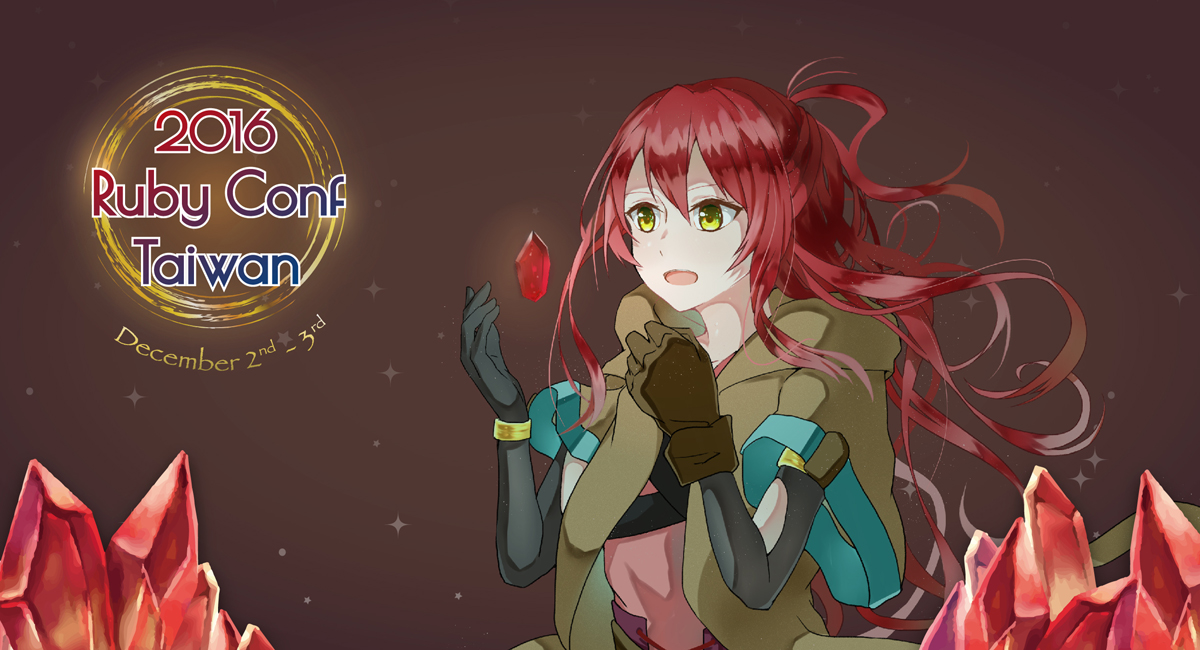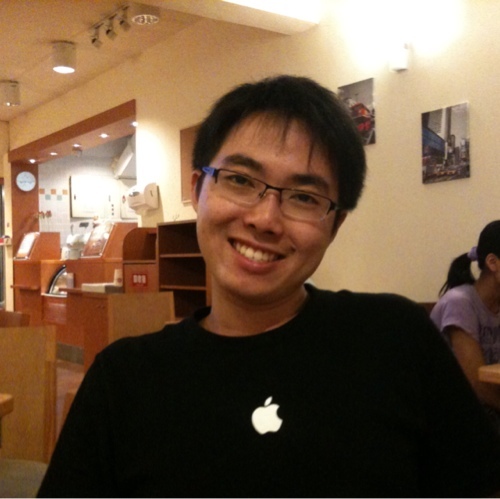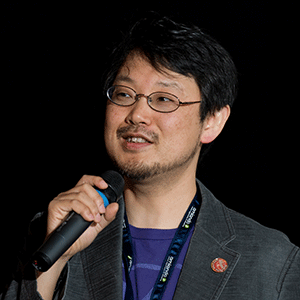2016
Ruby Conf
Taiwan
2016
Ruby Conf
Taiwan
December 2nd - 3rd
Activity Center, Academia Sinica
News
2016/12/3
Thank You!
2016/11/18
Schedule changed / 部份議程變更
2016/11/10
Submit your own un-conference event now!
Submit your own un-conference event now!
2016/11/10
不管你是不是不小心錯過徵稿截止日、或是有個有趣的主題想要跟會眾交流、還是想來點新鮮的主題,通通都歡迎,報名網址如下: / For the Unconference event, please submit your event or talk at the following url before 11/21.
http://rubytaiwan.kktix.cc/events/unconf2016
2016/11/1
Regular ticket Sales!
Regular ticket Sales!
2016/11/1
Early-bird tickets are now closed for sale. Regular tickets are now available at http://rubytaiwan.kktix.cc/events/rubyconftw2016
2016/10/30
Schedule released
2016/10/23
All keynote's talk detail were updated
2016/10/22
First round of CFP result has been sent
2016/10/20
開放早鳥票售票 / Early Bird Ticket Sales!

開放早鳥票售票 / Early Bird Ticket Sales!
2016/10/20
早鳥票的售票從今天開始到 10 月 31 日止,票價是優惠的 2000 元,之後只有 2,500 元的一般票喔,購票網址在:http://rubytaiwan.kktix.cc/events/rubyconftw2016,欲購從速! / Early bird sales are now open to 10/31 23:59(GMT+8)! Discounted price is NTD 2000 per ticket. Regular sales are NTD 2500. Make sure you get your early bird sales today on http://rubytaiwan.kktix.cc/events/rubyconftw2016 !
2016/10/18
We are reviewing all proposals
We are reviewing all proposals
2016/10/18
The review committee is now reviewing all 70 proposals and probably we will announce the result this Sunday or next Monday(10/24).
2016/10/11
The CFP will close 10/11 23:59(GMT+8).
The CFP will close 10/11 23:59(GMT+8).
2016/10/11
The CFP will close at 10/11 23:59 GMT+8, please submit your proposal before closed at https://cfp.rubyconf.tw/
Speaker

Konstantin Hasse
Co-Founder and CTO, Travis CI

Konstantin Hasse
Co-Founder and CTO, Travis CI
How we replaced salary negotiations with a Sinatra app

Luba Tang
CEO & founder, Skymizer

Luba Tang
CEO & founder, Skymizer
Ruby, facing the change of world-wide server-class microprocessors

Brad Urani
Principal Software Engineering, Procore

Brad Urani
Principal Software Engineering, Procore
Brad Urani loves talking, tweeting and blogging about software almost as much as he loves creating it. He's a veteran of 5 startups and a frequent conference and meetup speaker. He lives in Santa Barbara, California where he preaches the wonders of Ruby and relational databases as principal engineer at Procore.
Buidling HUGE web apps: Rails at 1,000,000 Lines of Code
There's big, and there's HUGE. Conventional wisdom says that huge teams with huge apps are slow and unresponsive. However, with great people, the right culture and diligent engineering, a team of 60 can perform like a team of 6. Join us for a story of HUGE. Learn which tools, patterns and practices help you manage growth, and which don't. Hear how trust in your teammates trumps consistency of design, and how scale changes priorities. Building a huge app takes focus and leadership, but if you prioritize people over process, you can stay fast, agile and bug free even when you're huge.

Chien-Wei Chu
CTO, 財報狗

Chien-Wei Chu
CTO, 財報狗
離開最接近硬體的C語言,轉向投入最接近人腦思考的Ruby developer。
現為財報狗CTO,主導財報狗數個重要技術專案,包含將網站由PHP無痛轉移至Rails、多個重要功能的效能大幅優化、打造高效率又可靠的爬蟲系統...等。
利用 Sidekiq Enterprise 打造高效率與高可靠度的爬蟲系統
在財報狗 (statementdog.com),我們提供友善的介面與大量的財務數據輔助股票投資人進行投資決策。這些數據的背後是由大量的爬蟲與運算邏輯程式碼所建構而成。在我們的資料庫中,每一檔股票各自都有近千項數據要抓取與計算,在總計數千檔股票都有近千項數據要處理的情況下,如何做到穩定又快速的更新數據與資訊,是一項不容易的任務。在這次的 talk 中,我們將會分享我們在建構系統時所面臨的挑戰、以及我們如何利用 Sidekiq Enterprise 打造出一個高效率又可靠的爬蟲系統。(本talk不探討如何撰寫crawler的相關議題,例如Nokogiri或Mechanise等相關gem的使用方式)

David Chang
Software engineer, Solda

Don Werve
Consultant, Minimum Viable

Don Werve
Consultant, Minimum Viable
Although originally designed by Apple in California as a durability-testing device for laptops, Don has spent the past seven years working around the world as a software engineer and back-pocket CTO, helping companies solve tough team management and scaling issues.
Don lives in Tokyo, and spends his spare time experimenting with advanced forms of deliciousness in his kitchen, hiking through the incredible beauty of the Japanese countryside, and training to survive the impending zombie apocalypse.
To Code Is Human
Mastering the art of programming requires both the ability to rapidly understand specific problem domains, as well as comprehensive working knowledge of software development tools, from individual libraries, to programming languages, to the fundamental limits of computing hardware itself.
But what is often neglected is an understanding of the most heavily-used and relied-upon tool in the software developer's toolbox: the programmer's brain itself.
In this talk, we will combine the art of programming with the science of cognitive psychology, and emerge with a set of simple, proven techniques that we can use to craft software that is drastically less buggy, easier to understand, and more adaptive in the face of change.

Eric Hodel
Fastly

Eric Hodel
Fastly
Eric Hodel is a ruby committer and maintainer of many gems. He works at Fastly on the API features team maintaining and building ruby services that customers use to configure their CDN services.
Building maintainable command-line tools with MRuby
MRuby and mruby-cli makes it possible to ship single binary command-line tools that can be used without setup effort. How can we make these easy to write too?
Existing libraries for making command-line tools are built for experienced rubyists. This makes them a poor choice for porting to MRuby.
In this talk we'll explore how to build a command-line tool with mruby-cli along with a design and philosophy that makes it easy to create new commands and maintain existing commands even for unfamiliar developers.

Florian Dutey
Senior Backend Engineer, Strikingly

Florian Dutey
Senior Backend Engineer, Strikingly
Hi, Im florian, I'm a web backend engineer for 9 years, using ruby since 2007. I'm from France, living in shanghai since 2013. I'm working with strikingly as ruby expert in backend team (also giving my 2 cents on front end from time to time). I'm mainly focused on data and code design (ie: not implementation) and DX (developper experience).
Large scale Rails applications
Rails patterns are amazing for prototyping, but they are actually very bad practices for large scale production applications. Also, Rails comes with lot of handy tools to break many barriers for web beginners while introducing tons of good practices. Again, those good practices are a good introduction, but they don't fit large scale production applications, especially when it comes to modern practices in front end world.
I will discuss why those patterns are not a fit, and how they can be replaced (completely dropped for another technology, or how to improve them). Delivering good practices that should be implemented as soon as your project is no more a prototype to scale your tests speed, your maintainability.

Harisankar P S
CEO/Chief Solutions Architect, Red Panthers Software Solutions (P) Ltd.

Harisankar P S
CEO/Chief Solutions Architect, Red Panthers Software Solutions (P) Ltd.
Harisankar P S has been building SaaS application and API's using Ruby and Rails for the past 5 years. He is also the founder of Red Panthers, a Ruby on Rails dev shop based out in Kochi, India. He is interested in open source and organizes Open Source Saturdays and Ruby Meetup in Kochi. He also contributes to open source as well.
Using database to pull your applications weight
Most Ruby on Rails application out there in the world deals with the manipulation and presentation of data. So the speed of our application has a relationship with how fast we work with data. Ruby on Rails, the swiss army knife of web development, is good with presenting data. But when it comes to crunching huge volumes of data, our rails application starts to slow down. Here we are not talking about joining a couple of rows from multiple tables, but about processing months of historical data and providing meaning full information.
Databases are good at processing data, but we sometimes make the mistake of just using it to as a file cabinet. The database is optimized to crunch GB's of data and return to us the results that we need.
So my talk would be about how to optimize your database so as to speed up your existing Ruby on Rails application.

Hiro Asari
Developer, Travis CI GmbH

Hiro Asari
Developer, Travis CI GmbH
Hiro Asari is a developer at Travis CI GmbH and core member of the JRuby team.
He is not very good at writing his own bio.
Ruby, HTTP/2 and You
HTTP/2 is here.
The first major revision since 1997 to Hypertext Transfer Protocol on which so much of the modern information transfer relies, HTTP/2 could have an enormous impact on the way we write applications.
Along with the history of HTTP and the current support status in the Ruby and Rails ecosystems, we will discuss how your web app can take advantage of HTTP/2.

Ivan Nemytchenko
Developer Advocate, Gitlab

Ivan Nemytchenko
Developer Advocate, Gitlab
14 years in IT. Rubyist since 2008. Being co-founder of two outsourcing companies. Co-organised two IT conferences. Organised online internship for junior ruby developers. In 2015 moved to Serbia, and later joined GitLab as Developer Advocate
Breaking Bad Habits with GitLab CI
GitLab is known in Ruby community for years. 2 years ago GitLab has made a huge leap forward by integrating CI system.
In this talk we’ll explore its functionality. The talk consists of two stories, where companies started from manual process, and step by step automated their it. Here’s what you will learn:
- how to execute a single command?
- how to run multiple commands in sequence?
- how to run them in parallel?
- how to pass artifacts between stages?
- how to deploy with GitLab CI?
- how to deploy to multiple environments?
You’ll be amazed how simple, yet powerful it is.

Juin Chiu
Web developer, iCook, Polydice Inc.

Julian Cheal
Senior Software Developer, Red Hat

Julian Cheal
Senior Software Developer, Red Hat
A British Ruby/Rails developer, with a penchant for tweed, fine coffee, and homebrewing. When not working for clients, I help organise fun events around the world that teach people to program flying robots. I also occasionally speak at international conferences on the intersection of programming and robotics.
It's More Fun to Compute
Come with us now on a journey through time and space. As we explore the world of analog/digital synthesis. From computer generated music to physical synthesisers and everything in between.
So you want to write music with code, but don’t know the difference between an LFO, ADSR, LMFAO, etc. Or a Sine wave, Saw wave, Google wave. We’ll explore what these mean, and how Ruby can be used to make awesome sounds. Ever wondered what Fizz Buzz sounds like, or which sounds better bubble sort or quick sort? So hey Ruby, let’s make music!

Kazuyuki Honda
DevOps Engineer, Quipper Ltd

Kazuyuki Honda
DevOps Engineer, Quipper Ltd
Kazuyuki loves Ruby and a cup of coffee. After working 9 years at IBM, M3 as a Java/Node.js web application developer, he joined EdTech company Quipper as a DevOps engineer. And now working on to make something automatic.
How to write complex data pipelines in Ruby
We often write a code to build data pipelines, which include multiple ETL process, summarize large size data, generate reports and so on. But it's not easy to write robust data pipelines in Ruby. Because there are many things to consider not only write a business logic but idempotence, dependency resolution, parallel execution, error handling and retry.
I'm working on it over 2 years, so I want to share how to write complex data pipelines in Ruby using tumugi, which is a gem I made.

Kei Sawada
Software Engineer, Recruit Holdings Co., Ltd.

Kei Sawada
Software Engineer, Recruit Holdings Co., Ltd.
Kei started his career in 2001 as a Tokyo-based software engineer and finally met Ruby in 2011. Ruby and its community quickly caught his attention and interest him very much, and since then he always picks up Ruby in the first place whenever he needs to make software. His most well-known project is Burn created in 2014, which is a toolkit to create 8-bit flavored application. He also plays the contrabass every weekend.
How I made a pure-Ruby word2vec program more than 3x faster
Ruby made programmers happy. I was no exception until I started to port original word2vec.c to Ruby. What was disappointing to me was the fact that large-scale scientific computation with CRuby is too time-consuming as the number of loops gets bigger. This experience led me to create VirtualModule, which lets you reduce execution time by running your arbitrary Ruby code on the other language VM process. In this talk, you will find out about when CRuby doesn't perform very well and what kind of bottlenecks you can workaround using VirtualModule.

Kiyoshi Nomo
Software engineer

Layne McNish
Software Engineer, Omada Health

Layne McNish
Software Engineer, Omada Health
Software Engineer at Omada Health in San Francisco, CA
Solving your onboarding problems with Ruby
Starting at a new company is hard. It's even harder when half the instructions and documentation to get you ready to code is out of date or missing key parts. We're Rubyists, not HR managers. Why don't we solve our issues through code instead of more Wikis and READMEs?

Satoshi Tagomori
Software Engineer, Treasure Data, Inc.

Satoshi Tagomori
Software Engineer, Treasure Data, Inc.
OSS developer/maintainer: Fluentd, Norikra, MessagePack-Ruby, Woothee and many others mainly about Web services, data collecting and distributed/streaming data processing. Living in Tokyo, and working for Treasure Data.
How to Write Middleware in Ruby
This presentation will show how to write middleware in Ruby.
Middleware are required: * to work well on various environment/platform * not to crash for unexpected data or unstability of network * not to consume cpu/memory or other resources unexpectedly * and many things
The presenter, a main developer of Fluentd, will show you many things to be considered, and many troubles/accidents we met.

Sebastian Sogamoso
Cookpad

Sebastian Sogamoso
Cookpad
Sebastián is a software developer that loves pair programming and has a passion for teaching. He works as a software engineer at Cookpad helping make everyday cooking fun. In his free time he is involved on the local software development groups and organize RubyConf Colombia.
He enjoys a good cup of Colombian coffee each morning which is his secret weapon to start the day in a great code-writing mood.
The overnight failure
This talk is based on a true horror story.
Imagine your work week ends after releasing a set of features to production. Your team is happy and you feel good about yourself. A call about a problem with payments wakes you up the next morning. You find out your most valuable users were charged hundreds of times, consuming their credit card limits, leaving others in overdraft. They're angry because they can't even buy milk at the store.
In this talk you'll learn how a "perfect bug storm" caused the problem, how our processes failed to catch it and how hard it was to gain our users and teammates trust back.

Shi-Gang Wang
Software engineer, Goldenio Technoloy

Shi-Gang Wang
Software engineer, Goldenio Technoloy
熟悉 ruby 和一點點的 bioinformation,試著把兩者結合,希望創造出有趣的東西。 任職於黃碼科技 Goldenio Techology。
Writing Data Analysis Pipeline As Ruby Gem
在分析 DNA/RNA 資料上,已有許多工具可供使用,可透過不同工具的結合,可以找出可能導致疾病或癌症的變異點,但工具繁雜,每套工具所需要的參數及使用方法不同,控制每個步驟相當麻煩,必須精通各種分析工具的用法。 希望透過這個 talk 讓聽眾暸解,要串接 C 和 JAVA 等語言撰寫的分析工具時,可以利用 RUBY 的套件,撰寫簡單的 code 來處理複雜的分析流程.我們將工具與參數的使用,撰寫成 RUBY 模組,並利用 templete 系統組合出一個 robust 的資料分析流程(Cagnut)。 執行分析流程通常會花費相當大的資源與時間,我們將以 Cagnut 為核心,探討如何撰寫輔助套件(cagnut-cluster),讓 Cagnut 可以運用不同 cluster 上的排程系統,如 LSF、SGE、Torque (PBS),達到節省分析巨量資料的時間。

Shi-Ken Don
Web Developer, 貝殼放大

Shi-Ken Don
Web Developer, 貝殼放大
土生土長的澎湖人,國中時因緣際會接觸到 VB6 從此對程式設計深深著迷,高中時踏入 Web Design & Web Security 的領域,但真正開始寫出東西是在大學一年級的暑假使用 PHP 寫出自己的網站,中間也陸續碰過 C++, Java, Python 等各種語言,目前最喜歡的語言是 Ruby,可以說到了沒有 Ruby 就不想寫程式的地步,現為貝殼放大的 Web Developer。
從零開始的爬蟲之旅
以過來人的經驗分享用 Ruby 每分鐘抓取 2000+ 頁面、維護上億筆紀錄資料庫的心路歷程,從單線程到多線程再到 Auto Scaling 讓大家一步一步體會撰寫爬蟲各階段可能遇到的瓶頸,期望能在未來為從事相關工作的朋友們帶來一點幫助。

TAI-AN SU

TAI-AN SU
三年電腦雜誌編輯,七年網頁應用程式開發。 母語是 Ruby,兼熟 JavaScript 及 Elixir。 滿分考的 JAVA 忘光了,總是在探索程式語言的本質。 Elixir.tw, RailsGirls 共同主辦人,RubyConf 講者。 喜歡貓,探戈,小說及下雨天。
Phoenix demythify, with fun
Phoenix 是根基於 Elixir 語言的 Web MVC 框架。除了 Elixir 與 Ruby 語法上的相似之外,這框架也從 Rails 「致敬」了許多概念及元件。這個講題會比較 Rails 與 Phoenix 在概念上相似及相異的部份,並告訴你用 Phoenix 開發時,哪些觀念及手法可以繼續使用,而哪些部份需要新的觀念,以及為什麼要這樣設計。
而對於正在使用 Rails 的開發者而言,也可以找一些 Rails 上的設計問題,及能適用於 Rails 的新手法及觀念。

Shyouhei Urabe
ruby-core committer, Money Forward, Inc.

Shyouhei Urabe
ruby-core committer, Money Forward, Inc.
Shyouhei is a long time ruby-core contributor. He was the branch mentor of 1.8.x in 1.8 era. He also introduced the ruby/ruby github repo back then. Today he is a full-timer to develop ruby interpreter at a fintech startup called Money Forward, inc. based in Japan.
Optimizing ruby core
I made ruby interpreter 10 times faster. Let me show you how.

Yasuko Ohba
President, Everyleaf Corporation

Yasuko Ohba
President, Everyleaf Corporation
A Ruby / Rails programmer in Tokyo, Japan. President of Everyleaf Corporation, which provides software development service mostly with Rails for clients since 2007. I have written 2 books on Ruby in Japan. A mother of a 3 year old girl.
Value And Pain to Keep Rails Applications Alive
In 2014-2015 my team migrated a series of applications from Rails 2.3.5 to 4.2.1, and Ruby 1.8 to 2.1. Our goal was to add large features, while substantially refactoring the whole system. It was a big challenge!
This talk will cover the timeline of the project and talk about all the things a team performing a large migration of Ruby and Rails will need to do. Secondly, I'll talk about importance, hardness, and some techniques to keep Rails applications healthy and maintainable.

Yatish Mehta
Engineer, Coupa Software

Yatish Mehta
Engineer, Coupa Software
Yatish Mehta, is a Software Engineer at Coupa Software. An NC State Graduate, he has also been a part of really interesting startups like Fab.com and Sungard. Yatish doesn’t shy away from talking about his first love, Ruby. While Ruby still remains his core competency, recently he’s begun exploring the mighty Golang as well. If you don’t find him experimenting with software, you’re sure to find him playing around in the kitchen. He lives by the motto, ‘I don’t have dreams, I have goals’... you guessed it right, he is a big Suits fan too.
ActionCable and ReactJS tie the knot
ActionCable is the new young prince of the Rails kingdom. He is young but powerful, en route to getting recognized for his skills? . ReactJS is the new princess of the JS kingdom. Recently, everyone has fallen head over heels in love with her. Together they are bound to create a powerful empire. Let’s watch the magic unveil as these two unite.

Yoh Osaki
Software engineer, Ubiregi inc.

Yoh Osaki
Software engineer, Ubiregi inc.
Yoh Osaki Software engineer at Ubiregi inc. Author of Hyalite which is react-like virtual DOM library. Member of Asakusa.rb, Chidoriashi.rb
Isomorphic web programming in Ruby
For JavaScript, The method is available that is the isomorphic programming. The isomorphic programming is the method exploiting the advantages obtained by same code running on both the server-side and client-side. For examle, React is reducing the overhead of iniitial rendering in client side by server side rendering. On the other hand, for the rubyists, We can also write ruby code on client side by using Opal.
This talk introduces a new framework for isomorphic programming with the Opal: Menilite. Menilite shares model code between the server side and the client side by marshalling objects and storing them in the database automatically. As a result, code duplication is reduced and APIs are no longer a necessity. Isomorphic programming can significantly accelerate your progress on a project; I sincerely hope you find it helpful in developing web applications. Menilite aims to expand the playing field for the Ruby language, a language optimized for developer happiness. I'm sure you will agree that we will find even more happiness by bringing Ruby to the front-end as well.
Schedule
We offer simultaneous interpretation service (Chinese to English) on all Chinese sessions!
Venue
Parties
Pre Party
Official Party
Code of conduct
All attendees, speakers, sponsors and volunteers at our conference are required to agree to following the code of conduct. Organizers will enforce this code of conduct throughout the event. We are expecting cooperation from all participants to help ensure a safe environment for everybody.
Harassment includes offensive verbal comments related to gender, gender identity and expression, age, sexual orientation, disability, physical appearance, body size, race, religion, sexual images in public spaces, deliberate intimidation, stalking, following, harassing photography or recording, sustained disruption of talks or other events, inappropriate physical contact, and unwelcome sexual attention.
Participants asked to stop any harassing behavior are expected to comply immediately. Sponsors are also subject to the anti-harassment policy. In particular, sponsors should not use sexualized images, activities, or other material. Booth staff (including volunteers) should not use sexualized clothing/uniforms/customes, or otherwise create a sexualized environment.
If a participant engages in harassing behavior, the conference organizers may take any action they deem appropriate, including warning the offender or expulsion from the conference with no refund. If you are being harassed, notice that someone else is being harassed, or have any other concerns, please contact a member of conference staff immediately. Conference staff will be visible by their special badges and clothing.
Conference staff will be happy to help participants contact hotel/venue security or local law enforcement, provide escort, or otherwise assist those experiencing harassment to feel safe for the duration of the conference. We value your attendance. We expect participants to follow these rules at all conference venues and conference-related social events.
This code of conduct is based off the work done at Conference Code of Conduct
所有此次活動的聽眾、演講者、贊助商和志工,都必須同意遵守下列行為準則。而主辦單位也將嚴格地執行這些準則,我們期待所有參加者的合作,以確保大家能有一個安全友善的環境。
騷擾包括有關性別,性別認同、年齡、性向、殘疾、外貌、體型、種族、宗教的攻擊性言語,或是在公共場合散播色情圖片、蓄意恐嚇、跟踪、騷擾性的攝影或錄影、多次打斷活動、不恰當的身體接觸,和讓人感到不舒服的性關注。
參與者必須停止任何騷擾行為並且立即遵守行為準則。
贊助商也必須遵守行為準則。贊助商不應該使用帶有性意味的圖像、活動,或其它材料。工作人員(包括志工)不該穿著帶有性意味的衣服/制服/裝扮,或是建立一個具有性意味的環境。
如果參與者從事騷擾行為,工作人員會採取其認為適當的任何手段,包括警告或是請離會場,並且不會退費。
如果你被騷擾、看到別人受到騷擾,或有任何其他問題,請立即聯繫會議工作人員,工作人員身上會穿戴可以識別身份的特殊徽章或衣服。
工作人員會很樂意幫助參與者聯繫酒店/場地警衛或當地警察、提供護送,或以其他方式幫助那些遇到騷擾的參與者感到安全。我們非常重視您的參與。
我們希望參與者在各活動場合、會議有關的社群活動都能遵循這些規則。
此行為準則是基於 Conference Code of Conduct ( http://confcodeofconduct.com/ ) 而訂定。























